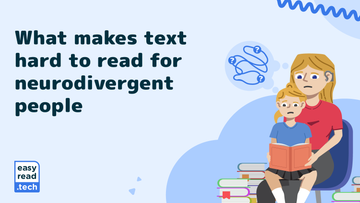What makes text hard to read for neurodivergent people

Graphics by Justin Olivares.
For many of us, opening up a webpage, or a printed brochure, and reading and comprehending the information in front of us is a straightforward task. However, for some members of our community, there are significant barriers that may prevent or make it very difficult for this to happen.
It is hard for many of us to step into the shoes of someone with a disability and fully comprehend the challenges they may face when doing something many of us take for granted every day. However, taking the first step to understanding these factors and their implications can pave the way for creating accessible and inclusive content that caters to a diverse audience, and fulfils its purpose more effectively for more people.
1. Characters looking too similar to each other
For people with vision impairment or a learning disability like dyslexia, there are some letters and numbers that practically look the same, and there are some font families that make the distinction even more difficult. This can make reading a text more time-consuming and difficult. Letters like a lower case ‘l’ and upper case ‘I’ can be difficult to discern, an ‘i’ and a ‘j’, as well as ‘e’, ‘c’ and ‘o’ characters.

Fonts like Arial, Verdana, and Calibri are preferred fonts for people with learning disabilities or reading difficulties. In general, sans serif fonts, meaning fonts that do not have the small lines or ‘serifs’ on the ends, are best to ensure accessibility in your print or digital written resources.
2. Characters being too close together
‘Tracking’ refers to the space between individual letters and characters in a word or section of a word.
‘Kerning’ refers to the spacing between two adjacent letters.
When characters are tracked tightly, individual letters can overlap and be hard to distinguish. For someone with low vision or dyslexia, a simple word can instead look like a mess of letters and shapes.
Furthermore, there are certain letter combinations that, with tight kerning, can look like a completely different letter. Take ‘r’ and ‘n’. When placed together tightly, it can start to look like an ‘m’. So, a word like ‘kerning’, could actually be read as ‘keming’. If ‘c’ and ‘l’ are placed together closely, you can take a word like ‘clear’ and misread it as ‘dear’.
On the other hand, too much space in between letters can also be a barrier, as it can look unnatural, and disrupt the flow of the text.

3. Jargon, complex terminology and technical language
Jargon, complex terminology or technical language are all forms of exclusive language, as they can only be easily understood by people within the specific industry, profession or group to which they relate. Furthermore, for people with disabilities, complex terms within a text pose an immediate barrier to comprehension, as decoding unfamiliar terms and concepts requires intense cognitive effort.
Even in an accessible format like Easy Read, comprehension is achieved due to the interplay of simple text and imagery, so the inclusion of images with difficult text will not fulfil a goal to be more accessible.
There will likely always be ways to simplify your text; but it’s all crucial to ensure that your text is simplified to your target audience and is free of unnecessarily complex language that requires extra time, tools or understanding to interpret.
4. Italics, underlining and all caps
Italics, underlining and all caps text can all be used sparingly in texts to emphasise certain words or phrases. However, when used excessively or with long sentences or paragraphs, the text can become difficult to read and detract from its legibility.
A study conducted in 2013 found a direct link between blocks of text in italic fonts and decreased reading performance for people with dyslexia.
5. Poor colour contrast
Document and website content is hard to read when the background colour looks too similar to the colour of the text, and the text is hard to discern. For readers with low vision, or experience colour-blindness, colour contrast is even more important to be able to navigate different elements in a resource and engage effectively with the content.
There are free online tools like the Web AIM contrast checker and the Vision Australia Colour Contrast Analyst that can be used to check the contrast ratio of a colour pairing and ensure optimal readability.
Colour contrast can also apply to logos, and an organisation’s colour palette, and the Accessible Colour Palette Builder can be a beneficial tool to ensure your organisational branding includes accessible colour combinations.

6. Lengthy blocks of text
Some neurodivergent readers may have difficulty sustaining their attention and focus to fully comprehend a text, especially if it is not broken up. Even for an unimpaired reader, a large block of text with no visual text hierarchy can be overwhelming to face.
By using elements such as headings and bullet points, and by breaking up your text into short paragraphs, neurodivergent readers can be better supported to concentrate and engage with a text.

It is important for us to recognise that not everyone reads or absorbs information in the same way, and the obstacles faced by neurodivergent people require careful consideration in content creation. By adopting inclusive design principles, you can make your content more accessible for a wider audience, and ensure that your resources are effective and engaging.
Contact easyread.tech today and discover how our expert team can support your organisation to transform resources into accessible formats, ensuring inclusivity for neurodivergent people.
